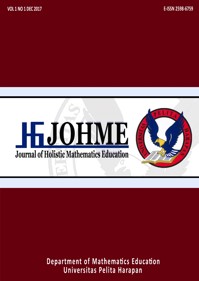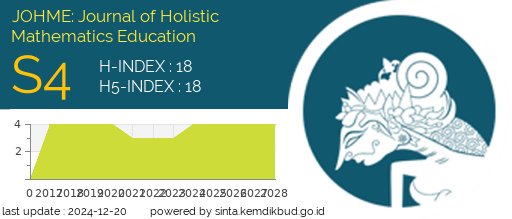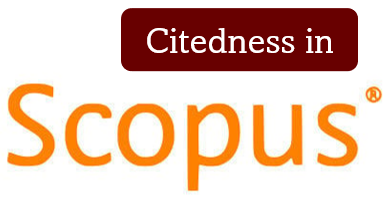Penerapan Metode Drill Untuk Meningkatkan Hasil Belajar Kognitif Siswa Kelas IX Materi Statistika di Smp Kristen Rantepao [The Implementation of the Drill Method to Improve Cognitive Learning Outcomes of Grade 9 Students Studying Statistics at a Christian Junior High School in Rantepao]
DOI:
https://doi.org/10.19166/johme.v1i1.718Schlagworte:
cognitive learning outcomes, drill method, hasil belajar kognitif, metode drillAbstract
In mathematics learning, the learning outcomes that are most often measured are the cognitive outcomes because they can be used in evaluating students’ achievement in the things they have learned. This research aimed to see whether the implementation of a drill method can improve the learning outcomes. The method used in this research is Classroom Action Research (CAR) using Kemmis & McTaggart’s model. This research was done in two cycles at a Christian junior high school in Rantepao in October 2016. The subjects were grade 9 students at the school. The instruments used in this research were mentor and peer observations, student’s questionnaire, and tests. The research concluded that the implementation of the drill method improved the cognitive learning outcomes of grade 9 students at the school.
ABSTRAK BAHASA INDONESIA: Dalam pelajaran matematika, hasil belajar yang paling sering diukur adalah hasil belajar kognitif karena itu dapat dijadikan bahan evaluasi untuk mengetahui pencapaian siswa akan hal yang sudah dipelajari. Penelitian ini bertujuan untuk melihat apakah penerapan metode drill dapat meningkatkan hasil belajar kognitif siswa. Metode penelitian yang digunakan adalah metode Penelitian Tindakan Kelas (PTK) model Kemmis dan Taggart. Penelitian dilakukan di SMP Kristen Rantepao pada kelas IX pada Oktober 2016 dalam dua siklus. Instrumen yang digunakan yaitu lembar observasi mentor dan teman sejawat, lembar angket siswa, dan tes. Hasil penelitian menyimpulkan bahwa penerapan metode drill dapat meningkatkan hasil belajar kognitif siswa kelas IX materi Statistika di SMP Kristen Rantepao.
Literaturhinweise
Arikunto, S. (2009). Dasar-dasar evaluasi pendidikan. Jakarta, Indonesia: Bumi Aksara.
Hamdani. (2011). Strategi belajar mengajar. Bandung, Indonesia: Pustaka Setia.
Juniati, E. (2017). Peningkatkan hasil belajar matematika melalui metode drill dan diskusi kelompok pada siswa kelas VI SD. Scholaria: Jurnal Pendidikan dan Kebudayaan, 7(3), 283-291. doi: https://doi.org/10.24246/j.scholaria.2017.v7.i3.p283-291
Kusumawati, E. & Irwanto, R. A. (2016). Penerapan metode pembelajaran drill untuk meningkatkan kemampuan pemecahan masalah matematis siswa kelas VIII SMP. EDU-M: Jurnal Pendidikan Matematika, 4(1), 49-57.
Majid, A. (2013). Strategi pembelajaran. Bandung, Indonesia: Remaja Rosdakarya.
Roestiyah. (2008). Strategi belajar mengajar. Jakarta, Indonesia: Rineka Cipta.
Romlah. (2004). Psikologi pendidikan. Malang, Indonesia: UMM Press.
Sagala. (2013). Konsep dan makna pembelajaran. Bandung, Indonesia: Alfabeta.
Sumiati & Asra. (2011). Metode pembelajaran. Bandung, Indonesia: CV Wacana Prima.
Sudjana, N. (2005). Penilaian hasil proses belajar mengajar. Bandung, Indonesia: Remaja Rosdakarya.
Suprihatiningrum, J. (2013). Strategi pembelajaran teori dan aplikasi. Jogjakarta, Indonesia: Ar-Ruzz Media.
Van Brummelen, H. (2009). Berjalan dengan Tuhan di dalam kelas. Jakarta, Indonesia: Universitas Pelita Harapan.
Winataputra. (2007). Teori belajar dan pembelajaran. Jakarta, Indonesia: Universitas Terbuka.
Wiriaatmadja, R. (2009). Metode penelitian tindakan kelas. Bandung, Indonesia: PT Remaja Rosdakarya.
Downloads
Zusätzliche Dateien
Veröffentlicht
Zitationsvorschlag
Ausgabe
Rubrik
Lizenz
Authors who publish with this journal agree to the following terms:
1) Authors retain copyright and grant the journal right of first publication with the work simultaneously licensed under a Creative Commons Attribution License (CC-BY-SA 4.0) that allows others to share the work with an acknowledgement of the work's authorship and initial publication in this journal.
2) Authors are able to enter into separate, additional contractual arrangements for the non-exclusive distribution of the journal's published version of the work (e.g., post it to an institutional repository or publish it in a book), with an acknowledgement of its initial publication in this journal.
3) Authors are permitted and encouraged to post their work online (e.g., in institutional repositories or on their website). The final published PDF should be used and bibliographic details that credit the publication in this journal should be included.”










